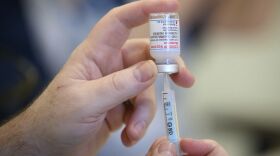Austin Public Health is updating its COVID-19 risk-staging chart because of the fast-spreading omicron variant. Health Authority Dr. Desmar Walkes announced the changes Tuesday morning, saying the variant is estimated to account for 90% of viral spread in Austin-Travis County according to the Centers for Disease Control and Prevention.
According to one model in areport on omicron from UT Austin’s COVID-19 Modeling Consortium, hospitals could face a record number of cases, hospitalizations and deaths — higher than during previous surges — if measures aren’t taken to slow the spread of disease.
Janet Pichette, chief epidemiologist for Austin Public Health, confirmed that three cases of omicron found at UT Austin last week had no history of international travel.
“So they had exposure and disease transmission here in the Austin-Travis County area," Pichette said. "What that tells me is we have community transmission of omicron right now and it is quickly taking over delta cases in our community.”
Austin-Travis County is currently in Stage 3 of APH’s risk-based guidelines. That’s based on key indicators, like the seven-day average of new COVID-19 hospital admissions in the Austin MSA, which currently stands at 15 per day.
Because of omicron, APH is lowering the threshold for entering the next highest level, Stage 4 (Stage 4 urges vaccinated people to mask in all scenarios).
According to APH’s revised risk chart, if the average of new hospital admissions is between 15 and 24, Austin-Travis County is in Stage 3 territory. Previously, the Stage 3 range was between 15 and 29. If the number rises to 25, the area could move to Stage 4, the second-highest level.
APH officials also take the community transmission rate into consideration when making staging changes. That’s the average number of cases per 100,000 people. Currently, the Austin area is seeing an average of about 114 cases per 100,000, which APH classifies as “high.”
“We are on the brink of Stage 4, and we need to act as such. We need to wear masks in all indoor situations, including indoor dining and shopping,” Walkes said. “Omicron’s arrival in Austin coincides with one of the busiest times of year, when people are traveling and gathering in groups for the holidays.”

Under Stage 3 in APH’s risk chart, fully vaccinated low-risk people are advised to wear masks indoors when gathering with people outside their home and while traveling. Fully vaccinated people who are at high risk should wear masks indoors at gatherings with people outside their home, while traveling and while dining and shopping.
Partially vaccinated or unvaccinated people who are low-risk should wear masks in all scenarios and get fully vaccinated. Partially vaccinated or unvaccinated high-risk people should avoid activities unless they are essential and get fully vaccinated.














